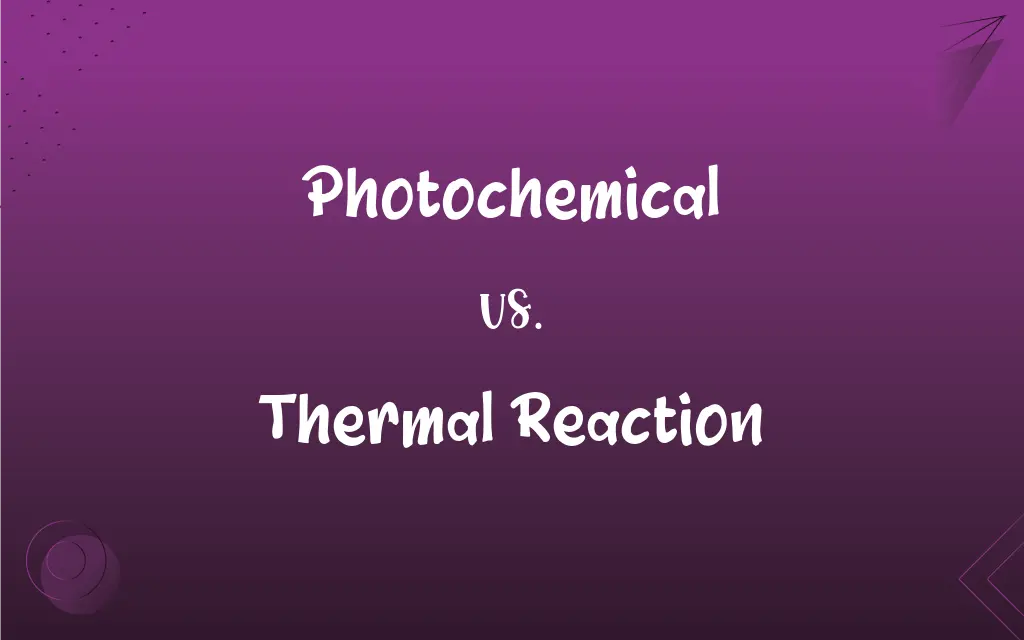Photochemical vs. Thermal Reaction: What's the Difference?
Edited by Aimie Carlson || By Janet White || Published on February 4, 2024
Photochemical reactions are driven by light energy, while thermal reactions are driven by heat energy.

Key Differences
Photochemical reactions occur when molecules absorb photons and undergo chemical changes, such as in photosynthesis. Thermal reactions, in contrast, are driven by heat, often involving the breaking or forming of bonds due to thermal energy, as seen in combustion.
In photochemical reactions, light provides the energy to overcome activation barriers, leading to unique reaction pathways. Thermal reactions rely on heat to provide the necessary energy for reactants to reach their activation energy.
Photochemical reactions can occur at lower temperatures due to energy absorption from light, as seen in the formation of ozone. Thermal reactions typically require higher temperatures to initiate and sustain the reaction, like in the cracking of hydrocarbons.
The rate of photochemical reactions is influenced by light intensity and wavelength. Thermal reaction rates, however, are affected by temperature and the presence of catalysts.
Photochemical processes are crucial in fields like photography and photopolymerization. Thermal reactions are fundamental in industries such as metallurgy and energy production.
ADVERTISEMENT
Comparison Chart
Energy Source
Light energy (photons)
Heat energy
Typical Environment
Can occur at lower temperatures
Requires higher temperatures
Activation Energy Overcoming
Provided by light absorption
Provided by thermal energy
Influence Factors
Light intensity and wavelength
Temperature, catalyst presence
Industrial Applications
Photography, photopolymerization
Metallurgy, energy production, cooking
ADVERTISEMENT
Photochemical and Thermal Reaction Definitions
Photochemical
Reactions initiated by the absorption of light.
Chlorophyll in plants uses photochemical processes for photosynthesis.
Thermal Reaction
Fundamental in industrial processes like energy production.
Power plants use thermal reactions for electricity generation.
Photochemical
Can proceed at lower temperatures with light energy.
Ozone formation in the upper atmosphere is a photochemical process.
Thermal Reaction
Rates affected by temperature and catalysts.
Catalysts in a car's engine accelerate thermal reactions for efficiency.
Photochemical
Characterized by unique pathways due to light activation.
UV light triggers photochemical reactions in sunscreen to protect skin.
Thermal Reaction
Reactions driven by heat energy.
Cooking involves thermal reactions that change food chemistry.
Photochemical
Involve changes in molecules due to photon absorption.
The photochemical reaction in film develops the image.
Thermal Reaction
Require higher temperatures for initiation.
Metal smelting is a thermal reaction requiring extreme heat.
Photochemical
Found in natural and artificial processes like photography.
Photography relies on photochemical reactions in the film.
Thermal Reaction
Often involve bond breaking and forming due to heat.
The thermal reaction in engines combusts fuel for energy.
Photochemical
The chemistry of the effects of light on chemical systems.
Photochemical
(chemistry) of, relating to, or produced by photochemistry or by photochemical reactions
Photochemical
Any chemical compound (such as silver halides) used in photography
Photochemical
Of or pertaining to chemical action of light, or produced by it; as, the photochemical changes of the visual purple of the retina.
Photochemical
Of or relating to or produced by the effects of light on chemical systems
FAQs
What defines a photochemical reaction?
A reaction initiated by the absorption of light energy.
Can photochemical reactions occur in the dark?
No, they require light to initiate and sustain the reaction.
What role do photochemical reactions play in photography?
They cause changes in film upon light exposure, developing images.
What's a natural example of a photochemical reaction?
Photosynthesis in plants is a natural photochemical process.
Is cooking considered a thermal reaction?
Yes, cooking involves thermal reactions to alter food chemistry.
How do temperatures affect thermal reaction rates?
Higher temperatures typically increase the rate of thermal reactions.
Are thermal reactions always fast?
Not necessarily; their rate depends on temperature and reactants.
How does heat drive a thermal reaction?
Heat provides the energy necessary to overcome activation barriers in reactants.
Can a catalyst be used in a thermal reaction?
Yes, catalysts can speed up thermal reactions.
How do light intensity and wavelength affect photochemical reactions?
They influence the rate and pathway of photochemical reactions.
Can photochemical reactions be harmful?
Yes, like UV light causing photochemical damage to skin cells.
What’s the importance of thermal reactions in energy production?
They are fundamental in converting fuels to usable energy forms.
Are all thermal reactions exothermic?
Not all; while many are exothermic, some can be endothermic.
Do photochemical reactions require specific wavelengths of light?
Yes, specific wavelengths can trigger certain photochemical processes.
What's an example of a thermal reaction in everyday life?
Boiling water is a simple example of a thermal reaction.
Do photochemical reactions require special conditions?
Apart from light, they often need specific reagents and conditions.
Are thermal reactions used in material processing?
Yes, in processes like metal smelting and plastic molding.
Can thermal reactions be controlled precisely?
Yes, with precise temperature control and reaction engineering.
Are photochemical reactions used in industry?
Yes, in processes like photopolymerization and curing of coatings.
How does light quality affect photochemical reaction outcomes?
Different light qualities can lead to different products and reaction rates.
About Author
Written by
Janet WhiteJanet White has been an esteemed writer and blogger for Difference Wiki. Holding a Master's degree in Science and Medical Journalism from the prestigious Boston University, she has consistently demonstrated her expertise and passion for her field. When she's not immersed in her work, Janet relishes her time exercising, delving into a good book, and cherishing moments with friends and family.
Edited by
Aimie CarlsonAimie Carlson, holding a master's degree in English literature, is a fervent English language enthusiast. She lends her writing talents to Difference Wiki, a prominent website that specializes in comparisons, offering readers insightful analyses that both captivate and inform.







































































